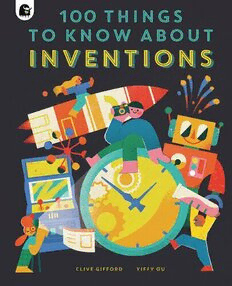
100 Things to Know About Inventions (In a Nutshell) PDF
Preview 100 Things to Know About Inventions (In a Nutshell)
100 THINGS TO KNOW ABOUT INVENTIONS INVENTIONS Author: Clive Gifford Illustrator: Yiffy Gu Designer: Sarah Chapman-Suire Editor: Carly Madden Creative Director: Malena Stojic Publisher: Rhiannon Findlay © 2021 Quarto Publishing plc Illustration © 2021 Yiffy Gu Yiffy Gu has asserted her moral right to be identified as the illustrator of this Work in accordance with the Copyright Designs and Patents Act 1988. First published in 2021 by Happy Yak, an imprint of The Quarto Group. The Old Brewery, 6 Blundell Street, London N7 9BH, United Kingdom. T (0)20 7700 6700 F (0)20 7700 8066 www.quartoknows.com No part of this publication may be reproduced, stored in a retrieval system, or transmitted in any form, or by any means, electrical, mechanical, photocopying, recording or otherwise, without the prior written permission of the publisher or a licence permitting restricted copying. In the United Kingdom such licences are issued by the Copyright Licensing Agency, 5th Floor, Shackleton House, 4 Battle Bridge Lane, London SE1 2HX A catalogue record for this book is available from the British Library. ISBN 978 0 7112 6344 4 eISBN 978 0 7112 6345 1 Manufactured in Guangdong, China TT062021 9 8 7 6 5 4 3 2 1 100 THINGS TO KNOW ABOUT INVENTIONS INVENTIONS CLIVE GIFFORD Yiffy gU CONTENTS 6 Introduction 22 VACUUM 38 TELEGRAPH 54 PRINTING 23 REFRIGERATOR 39 INTERNET 55 World wide web 8 WHEEL 24 PHOTOGRAPHY 40 CRASH TEST DUMMY 56 SEARCH ENGINE 9 SKATES 25 DIGItal camera 41 SEAT BELT 57 TRAIN 10 STEAM 26 BALLOON 42 CONSOLE 58 PAPER BAG 11 LOOM 27 SUBMARINE 43 ARCADE 59 COIN 12 CRANE 28 WRITING 44 AIRCRAFT 60 SMARTPHONE 13 LEGO® 29 BRAILLE 45 PARACHUTE 61 EMOJI 14 PLOUGh 30 CAR 46 PLASTER 62 SUPERGLUE 15 LAWNMOWER 31 TRAFFIC LIGHTS 47 PACEMAKER 63 POST-IT® NOTE 16 PHOTOCOPIER 32 PAPER 48 CHOCOLATE 64 SCUBA 17 3D PRINTING 33 PENCIL 49 DYE 65 spacecraft 18 COMPUTER 34 BATTERY 50 JET 66 light bulb 19 MICROcHIP 35 GENERATOR 51 ROCKET 67 FILAMENT 20 PATENT 36 TOILET 52 FROZEN FOOD 68 FIREWORK 21 SAFETY PIN 37 TOOTHBRUSH 53 MICROWAVE 69 neon 70 airship 86 SATELLITE 102X-RAY 71 HELICOPTER 87 SPACE STATION 103PHOTOVOLTAIC 72 RADIO waves 88 CINEMA 104WIPER 73 TELEVISION 89 SMELL-O-VISION 105CAT'S EYE 74 TELESCOPE 90 AC 106BARCODE 75 MICROSCOPE 91 TURBINE 107 LASER 76 MICROCOMPUTER 92 VELCRO® 77 ROBOT 93 TRAMPOLINE 108AUTHOR'S NOTE & 78 BICYCLE 94 TELEPHONE YOUNG INVENTORS 79 KEVLAR® 95 HEADPHONES 110 TIMELINE & 80 STAMP 96 DISHWASHER GLOSSARY 81 BUBBLE WRAP 97 SLICED BREAD 112 INDEX & 82 TIMEKEEPING 98 PHONOGRAPH FIND OUT MORE 83 PENDULUM 99 STREAMING 84 MOUSE 100PLASTIC 85 BIRO 101 BARBIE® 6 7 INTRODUCTION Every day, when you switch on a light, computer or radio, ride your bike, write a note or open the fridge, you are using objects and materials that didn’t exist centuries earlier. These inventions didn’t spring out of thin air – they’re all the work of ingenious, hardworking and sometimes, downright lucky, inventors! Some inventions come in a sudden flash of inspiration, whilst others take many years of hard graft to make them work. Many inventions do not succeed, but when they do they have the potential to transform the way many people live. This book celebrates the importance of innovations by examining 100 key examples of inventions, big and small. Some have changed the world, while others have made daily life a little bit easier or more rewarding. All have fascinating and sometimes surprising stories to tell and will give you lots to think and talk about. So what are you waiting for? The world of inventions is just a page turn away! 8 WHEEL Many inventions evolve out of new ways of using existing things. In Mesopotamia (present day Iraq), 5,500–6,000 years ago, people created simple potters’ wheels by spinning circular slabs of wood or stone positioned parallel to the ground. Around 3,500 BCE, some bright sparks began placing wheels on their side and inserting a rod through the middle as an axle, so the wheel could turn. Wheels encounter far less friction than an object that is dragged across the ground, so when fitted to carts – pulled by oxen or mules – wheels made moving people, crops and other goods around quicker and easier.
